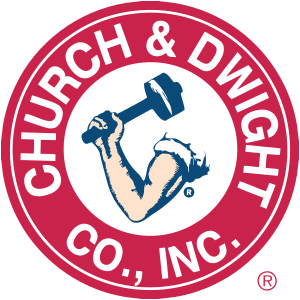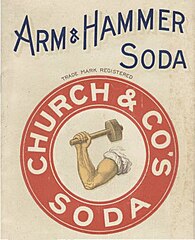About Church & Dwight
We like Church & Dwight already. A storied consumer products company with a variety of likely familiar household brands under its corporate umbrella.
Founded in 1847 by John Dwight and his brother-in-law, Austin Church, the brothers reportedly began their partnership by selling baking soda that they originally “refined in Dwight’s kitchen.” No wonder one of their most notable brands is Arm & Hammer, one of the most famous consumer staple brands on the planet.

However, as we alluded to previously, there is more brand power to Church & Dwight than just Arm & Hammer.
Specifically, the company also owns OxiClean (cleaner and stain remover), XTRA (laundry detergent), First Response (pregnancy tests), KABOOM (bathroom cleaner), Orajel (cosmetics, toothpaste, toothbrushes, cold sore relief, and other mouth-related care) and many other brands that aren’t as popular (at least, I don’t remember seeing or using them before).
So, we’ve established that Church & Dwight is a lean, mean cleaning machine with a handful of strong brands. In fact, its brands are so strong that we see the company similar to how we saw Colgate-Palmolive, analyzed in one of our previous in-depth stock analysis articles. However, as investors, we can’t merely assume that Colgate-Palmolive and Church & Dwight are one in the same; that would make us lazy and uninformed investors!
Instead, we are now going to discuss the fundamentals and numbers behind Church & Dwight and gain a better understanding of how financially stable and promising the company is.
Church & Dwight’s financials
As of this writing (4/12/2022), Church & Dwight has a market capitalization of $25.2 billion. The company also has a current share price of $103.91 paired with a price-to-earnings (P/E) ratio of 31.21.
Their current P/E ratio implies that the company’s share price is currently too high when compared to CHD’s intrinsic value, or what the company is worth today. This makes sense given the run-up in demand for consumer products in recent history. The heightened demand likely stems from consumers stockpiling products or buying in bulk, possibly to hedge against future price hikes or other inflationary pressures.
Nonetheless, the fact of the matter is that according to their current P/E, Church & Dwight’s stock price is too high and would be at or close to fair value (an accurate reflection of what the company is worth) at a P/E at 20, not 31.21.
Church & Dwight’s balance sheet
Digging a little deeper into Church & Dwight’s financials, according to their balance sheet, they oversee total assets of just shy of $8 billion and total liabilities of approximately $4.7 billion. Personally, I would have assumed the company maintained a higher amount of total liabilities, however, my team and I were pleasantly surprised when we saw a wider gap between their total assets and total liabilities.

The consumer goods space is a relatively tough one, with a lot of operations, materials, commodity prices to worry about, facilities to manage and customer and store relationships to nurture as well.
This is mainly why I would’ve thought the company had a larger amount of total liabilities attached to its name. However, another pleasant surprise came when I saw that there’s been a general downtrend of Church & Dwight’s total liabilities. Specifically, while their total liabilities have been in a general uptrend in the past five reported years, the company’s total long term debt appears to be in a general downtrend in that same time frame.
Why does this matter?
As an investor, this signals to me that Church & Dwight is intent on hewing down its current level of long term debt, even though it’s not astronomically high, and has also been achieving this during the COVID-19 pandemic and supply chain crisis that has likely impacted their bottom line.
Ultimately, this shows that the company is in a fortified position to continue providing for its customers while keeping their financials sound.
This should be quite assuring for investors considering buying the stock. CHD is starting to look more and more like a “store of value” stock.
But of course, we can’t stop here and celebrate yet. Let’s talk about some of the other financials driving Church & Dwight.
Church & Dwight’s financials continued
Onto the company’s income statement, their total revenue has been steadily increasing each year of the past five years. For such an established company, it’s promising and borderline incredible they are increasing sales and revenue numbers over the past five years.
Frankly, we wouldn’t be as excited or think it was that impressive if their total revenue was essentially flat from 2017 to 2019 and then in 2020, their revenues skyrocketed. That’s not sustainable growth, that’s just heightened demand that could artificially raise investors’ expectations.
Thankfully, this doesn’t seem to be the case with Church & Dwight.
Specifically, in 2017 the company’s total revenue stood at around $3.7 billion, increasing to approximately $4.1 billion in 2018 and steadily rising in subsequent years. Of course, it should be noted that there was a relatively large jump in total revenue between 2020 and 2021 (around $4.8 billion to $5.1 billion, respectively), likely fueled by the pandemic-driven demand for the company’s products.
Now, that’s the past and unfortunately, we can’t invest retroactively! If we could, I would’ve put every cent to my name in Amazon stock in the late 90s!
The question becomes whether or not this sort of growth is sustainable for the coming years, decades and even centuries.
Church & Dwight’s future
Personally, I believe shallow to modest revenue growth is in Church & Dwight’s financial future; I love that.
Publicly traded staples that grow their revenue at a stable and sustainable pace get the chef’s kiss from me.
While this company’s stock price is objectively overvalued, the company itself has seen a lot of steady growth fundamentally and from my perspective, this is likely to continue. People are always going to need cleaning, laundry and oral care products, no matter how bad the state of the economy.
Therefore, Church & Dwight will likely continue to capitalize from whatever storms the economy may offer. This is one of the primary ways in which Church & Dwight is similar to Colgate-Palmolive.

Another way in which the two consumer product giants are similar is their pricing power. Specifically, as it relates to Church & Dwight, reports have emerged alleging that the company “expects to raise prices on 80% of its brands by February (2022).”
As an investor, this should make you happy; as a consumer, this likely makes you unhappy and borderline furious.
Regardless, Church & Dwight is likely to benefit from the price hikes in both the intermediate and long term.
As we dig a little further into the company’s core financials, their cash flow has been stable overall, standing at $743 million in 2017 and $828 million in 2021. In order to grow, the company is likely to reinvest in its portfolio of companies while potentially seeking new acquisitions going forward. Typically, when a company reinvests or acquires another company or business, the acquirer’s net income falls that year because they’ve made a new investment and spent a considerable amount of money on their purchase.
The company does offer an annual dividend of $1.05 which is a nice perk for investors. Additionally, Church & Dwight’s annual return on assets is basically in line with the industry (expected) and their annual return on investment is slightly lower than the industry.
If the company’s annual return on investment was significantly lower than that of the industry, we would be concerned, however, it’s just a few points lower and could be caused by inflationary pressures the company has experienced in the past and might be currently experiencing.
If this were the case, this is a sector-wide issue and isn’t necessarily a negative reflection of Church & Dwight.
Finally, the company’s ability to pay down its debt over time appears very promising, as their “operating profits are 16.91x greater than interest payments,” according to TD Ameritrade’s brokerage platform.
Should you buy Church & Dwight stock?
If you want to play risky and invest in potential growth, you’re reading the wrong article.
If you want to gamble instead of invest, you shouldn’t buy Church & Dwight.
Given the company’s relative strength and pricing power, universal product presence, relatively low total liabilities (compared to total assets) and recession-proof business model, we give Church & Dwight a “buy” rating.
DISCLAIMER: This analysis of the aforementioned stock security and/or company is in no way to be construed or understood as professional investment advice. We are simply expressing our opinion(s) regarding the publicly traded entity.